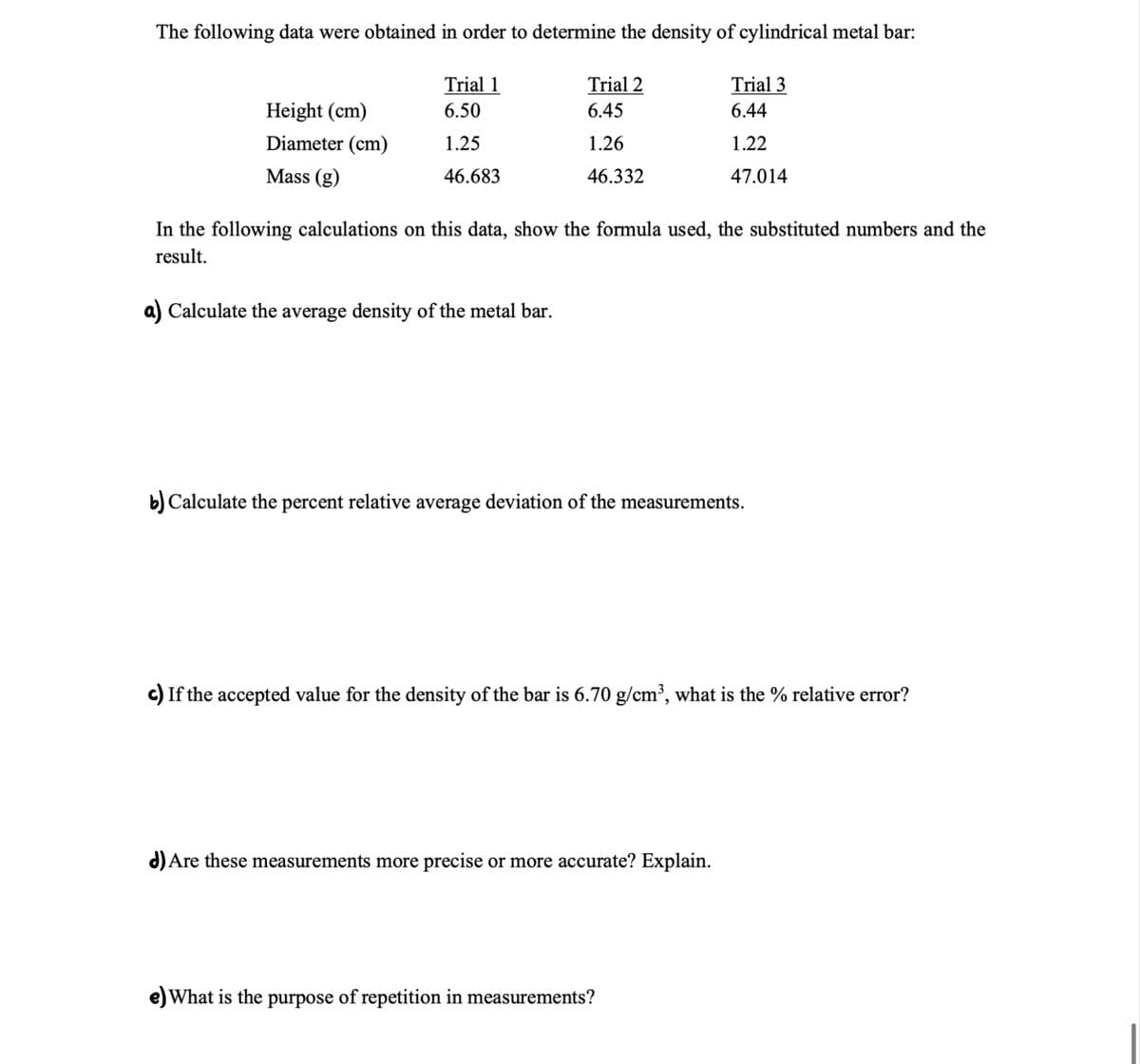The following data were obtained in order to determine the density of cylindrical metal bar: Trial 1 Trial 2 Trial 3 Height (cm) 6.50 6.45 6.44 Diameter (cm) 1.25 1.26 1.22 Mass (g) 46.683 46.332 47.014 In the following calculations on this data, show the formula used, the substituted numbers and the result. a) Calculate the average density of the metal bar. b) Calculate the percent relative average deviation of the measurements. c) If the accepted value for the density of the bar is 6.70 g/cm³, what is the % relative error? d) Are these measurements more precise or more accurate? Explain. e) What is the purpose of repetition in measurements?
The following data were obtained in order to determine the density of cylindrical metal bar: Trial 1 Trial 2 Trial 3 Height (cm) 6.50 6.45 6.44 Diameter (cm) 1.25 1.26 1.22 Mass (g) 46.683 46.332 47.014 In the following calculations on this data, show the formula used, the substituted numbers and the result. a) Calculate the average density of the metal bar. b) Calculate the percent relative average deviation of the measurements. c) If the accepted value for the density of the bar is 6.70 g/cm³, what is the % relative error? d) Are these measurements more precise or more accurate? Explain. e) What is the purpose of repetition in measurements?
Chemistry
10th Edition
ISBN:9781305957404
Author:Steven S. Zumdahl, Susan A. Zumdahl, Donald J. DeCoste
Publisher:Steven S. Zumdahl, Susan A. Zumdahl, Donald J. DeCoste
Chapter1: Chemical Foundations
Section: Chapter Questions
Problem 1RQ: Define and explain the differences between the following terms. a. law and theory b. theory and...
Related questions
Question

Transcribed Image Text:The following data were obtained in order to determine the density of cylindrical metal bar:
Trial 1
Trial 2
Trial 3
Height (cm)
6.50
6.45
6.44
Diameter (cm)
1.25
1.26
1.22
Mass (g)
46.683
46.332
47.014
In the following calculations on this data, show the formula used, the substituted numbers and the
result.
a) Calculate the average density of the metal bar.
b) Calculate the percent relative average deviation of the measurements.
c) If the accepted value for the density of the bar is 6.70 g/cm³, what is the % relative error?
d) Are these measurements more precise or more accurate? Explain.
e) What is the purpose of repetition in measurements?
Expert Solution
This question has been solved!
Explore an expertly crafted, step-by-step solution for a thorough understanding of key concepts.
This is a popular solution!
Trending now
This is a popular solution!
Step by step
Solved in 3 steps with 3 images

Knowledge Booster
Learn more about
Need a deep-dive on the concept behind this application? Look no further. Learn more about this topic, chemistry and related others by exploring similar questions and additional content below.Recommended textbooks for you

Chemistry
Chemistry
ISBN:
9781305957404
Author:
Steven S. Zumdahl, Susan A. Zumdahl, Donald J. DeCoste
Publisher:
Cengage Learning

Chemistry
Chemistry
ISBN:
9781259911156
Author:
Raymond Chang Dr., Jason Overby Professor
Publisher:
McGraw-Hill Education

Principles of Instrumental Analysis
Chemistry
ISBN:
9781305577213
Author:
Douglas A. Skoog, F. James Holler, Stanley R. Crouch
Publisher:
Cengage Learning

Chemistry
Chemistry
ISBN:
9781305957404
Author:
Steven S. Zumdahl, Susan A. Zumdahl, Donald J. DeCoste
Publisher:
Cengage Learning

Chemistry
Chemistry
ISBN:
9781259911156
Author:
Raymond Chang Dr., Jason Overby Professor
Publisher:
McGraw-Hill Education

Principles of Instrumental Analysis
Chemistry
ISBN:
9781305577213
Author:
Douglas A. Skoog, F. James Holler, Stanley R. Crouch
Publisher:
Cengage Learning

Organic Chemistry
Chemistry
ISBN:
9780078021558
Author:
Janice Gorzynski Smith Dr.
Publisher:
McGraw-Hill Education

Chemistry: Principles and Reactions
Chemistry
ISBN:
9781305079373
Author:
William L. Masterton, Cecile N. Hurley
Publisher:
Cengage Learning

Elementary Principles of Chemical Processes, Bind…
Chemistry
ISBN:
9781118431221
Author:
Richard M. Felder, Ronald W. Rousseau, Lisa G. Bullard
Publisher:
WILEY